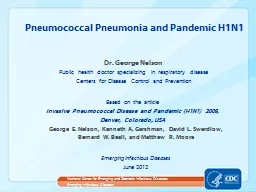PPT-Dr. George Nelson
Author : celsa-spraggs | Published Date : 2016-06-19
Public health doctor specializing in respiratory disease Centers for Disease Control and Prevention Pneumococcal Pneumonia and Pandemic H1N1 Emerging Infectious
Presentation Embed Code
Download Presentation
Download Presentation The PPT/PDF document "Dr. George Nelson" is the property of its rightful owner. Permission is granted to download and print the materials on this website for personal, non-commercial use only, and to display it on your personal computer provided you do not modify the materials and that you retain all copyright notices contained in the materials. By downloading content from our website, you accept the terms of this agreement.
Dr. George Nelson: Transcript
Download Rules Of Document
"Dr. George Nelson"The content belongs to its owner. You may download and print it for personal use, without modification, and keep all copyright notices. By downloading, you agree to these terms.
Related Documents














